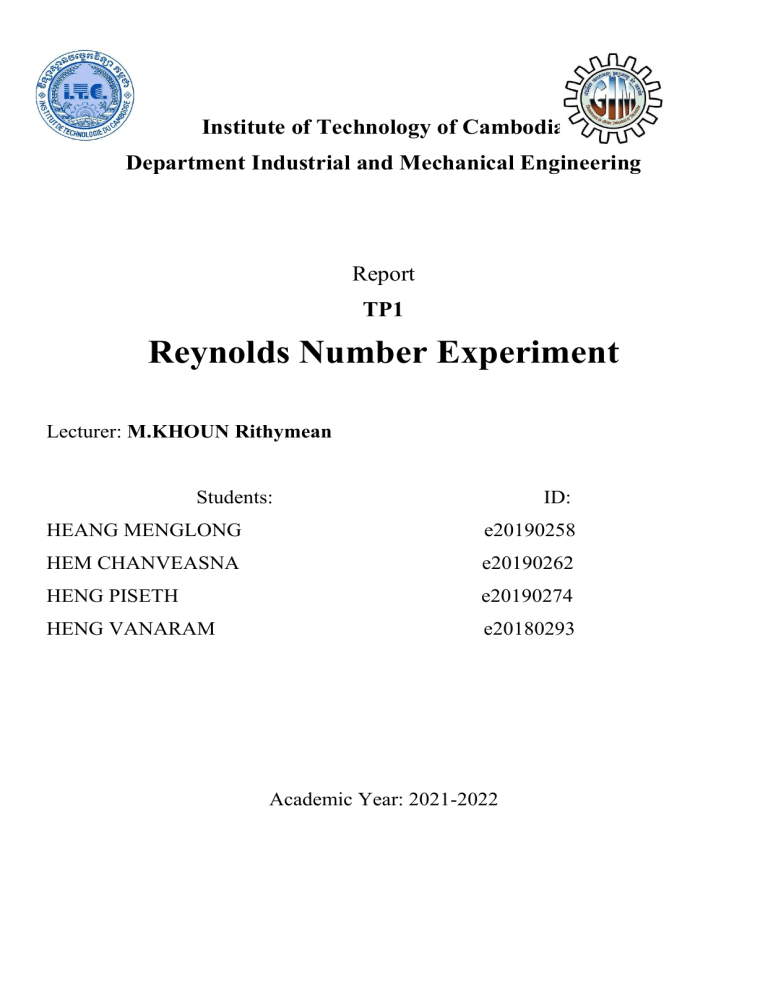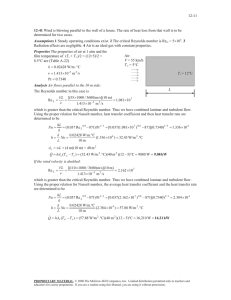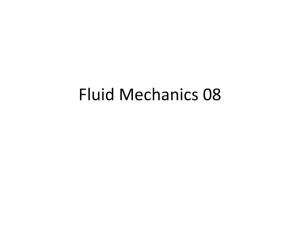
Institute of Technology of Cambodia Department Industrial and Mechanical Engineering Report TP1 Reynolds Number Experiment Lecturer: M.KHOUN Rithymean Students: ID: HEANG MENGLONG e20190258 HEM CHANVEASNA e20190262 HENG PISETH e20190274 HENG VANARAM e20180293 Academic Year: 2021-2022 Contents I. Introduction ..................................................................................................................... 1 II. Objective ......................................................................................................................... 1 III. Theory ............................................................................................................................. 1 IV. Procedure` ....................................................................................................................... 2 V. Results ............................................................................................................................. 3 VI. Data analysis and Discussion ........................................................................................... 3 VII. Conclusion.................................................................................................................... 4 I. Introduction The Reynolds number is the ratio of inertial forces to viscous forces within a fluid which is subjected to relative internal movement due to different fluid velocities. A region where these forces change behavior is known as a boundary layer, such as the bounding surface in the interior of a pipe. II. Objective To illustrate laminar, transitional, and fully turbulent pipe flows, and to determine the conditions under which these types of flow happen. The equipment consists of a hydraulics bench, an Osborne Reynolds apparatus, dye, a thermometer, flow meter. The diameter of the flow visualization pipe is d=15mm. III. Theory Having identified the various flow regimes, Reynolds attempted to identify the factors (or variables) that influenced the flows regime and the relationship between them. That is, to answer the question: ‘If fluid flows through a straight duct or pipe, will the flow be laminar or turbulent?’ He found that three main factors influenced the flow regime: • • • Fluid velocity: the higher the velocity, the greater is the tendency for turbulence; Fluid viscosity: the lower the viscosity, the greater is the tendency for turbulence; Pipe diameter: the larger the pipe diameter, the greater is the tendency for turbulence. Reynolds was able to express the relationship between these variables by a single number (now known as the Reynolds number) given by: 𝑅𝑒 = 𝜐𝑑 𝜐𝑑𝜌 = 𝜈 𝜇 Where 𝜐 = velocity of the fluid in 𝑚/𝑠 𝑑 = diameter of the pipe or tube in m 𝜌 = density of the fluid in 𝑘𝑔/𝑚3 𝜈 = kinematic viscosity of the fluid in 𝑚2 /𝑠 𝜇 = dynamic viscosity of the fluid in 𝑃𝑎. 𝑠 The smaller the Reynolds number, the greater is the likelihood of laminar flow, and the greater the Reynolds number, the greater is the likelihood of turbulent flow. That is, laminar flow is likely only with relatively high viscosity fluids flowing with relatively low velocity through relatively small-bore pipes or tubes. Reynolds number is a dimensionless number, that is, it has no units (when a consistent system of units is used). 1 IV. Procedure` • • • Fill the reservoir of dye injector with dye and lower it until it is just above the bellmouth inlet. With the flow control valve closed, slowly fill the head tank with water to the overflow level, then close the inlet valve. Open and close flow control valve to admit water to the flow visualization pipe. Allow the apparatus to stand at least ten minutes before proceeding. Open the inlet valve slightly until water trickers from the outlet pipe. The open the control valve for a small amount, so that a low-speed flow occurs in the pipe. Turn on the valve controlling the dye injection. The traces of the dye in the flow visualization pipe illustrate the character of the flow. Initially, the dye should remain in a steady, narrow stream, indicating laminar flow. Next, adjust the flow with valve up between 50 to 210 and down between 210 to 50 and observe the type of flow. 2 V. Results Measurements And Calculations Measurements And Calculations Water temperature 0 Kinematic viscosity Flow meter Calculations Flow rate Velocity Decision Reynolds number Error Theoretical decision Visual decision N T(oC) v(m2/s) QR(L/h) Q(m3/s) V(m/s) Re 1 30 0.000000796 50 0.00001389 0.078595034 1481.062191 L L 2 30 0.000000796 90 0.00002500 0.141471061 2665.911945 Tr Tr 3 30 0.000000796 130 0.00003611 0.204347087 3850.761698 Tr T 4 30 0.000000796 170 0.00004722 0.267223114 5035.611451 T T 5 30 0.000000796 210 0.00005833 0.330099141 6220.461204 T T 6 30 0.000000796 170 0.00004722 0.267223114 5035.611451 T Tr 7 30 0.000000796 130 0.00003611 0.204347087 3850.761698 Tr Tr 8 30 0.000000796 90 0.00002500 0.141471061 2665.911945 Tr Tr 9 30 0.000000796 50 0.00001389 0.078595034 1481.062191 L L 3.73 % 25.9 % VI. Data analysis and Discussion ➢ Equation 1 We see the Reynolds number is the dimensionless quantity because 𝑅𝑒 = 𝑑𝑉𝜌 𝜇 = (𝑚)(𝑚.𝑠−1 )(𝐾𝑔.𝑚−3 ) 𝐾𝑔.𝑚−1 .𝑠−1 = 𝑁𝑜 𝑢𝑛𝑖𝑡 We see that all the unit are cancelled out, Reynolds is dimensionless. ➢ Flow rate from bottom to top and top to bottom • Instance 𝑄𝑅 = 50𝐿/ℎ, 𝑅𝑒 = 1481 theoretically the flow rate is laminar and our experiment showed that it is laminar. • Instance 𝑄𝑅 = 90𝐿/ℎ, 𝑅𝑒 = 2666 theoretically the flow rate is transitional and our experiment showed that it is transitional. • Instance 𝑄𝑅 = 130𝐿/ℎ, 𝑅𝑒 = 3851 theoretically the flow rate is transitional and our experiment showed that it is turbulent. • Instance 𝑄𝑅 = 170𝐿/ℎ, 𝑅𝑒 = 5036 theoretically the flow rate is turbulent and our experiment showed that it is turbulent. • Instance 𝑄𝑅 = 210𝐿/ℎ, 𝑅𝑒 = 6221 theoretically the flow rate is turbulent and our experiment showed that it is turbulent. • Instance 𝑄𝑅 = 170𝐿/ℎ, 𝑅𝑒 = 5036 theoretically the flow rate is turbulent and our experiment showed that it is transitional. • Instance 𝑄𝑅 = 130𝐿/ℎ, 𝑅𝑒 = 3851 theoretically the flow rate is transitional and our experiment showed that it is transitional. • Instance 𝑄𝑅 = 90𝐿/ℎ, 𝑅𝑒 = 2666 theoretically the flow rate is transitional and our experiment showed that it is transitional. • Instance 𝑄𝑅 = 50𝐿/ℎ, 𝑅𝑒 = 1481 theoretically the flow rate is laminar and our experiment showed that it is laminar. 3 The main causes why the result differ from theoretical because • • • • Personal error (visual judgement) Environment (vibration, water clarity) Increase flow rate Equipment ➢ The two quantities do the Reynolds number incorporate are inertial force and viscous force. The Reynolds force is significance because it attempts to identify the factor (𝑉, 𝑑, 𝜌, 𝜇) that influence the flow regime and the relationship between them and ultimately the determine the flow regime. ➢ Several other dimensionless factor 𝜈 • Froude number: 𝐹𝑟 = , √𝑔𝐿 Where, L = length of flow (m) v = velocity of flow (m/s) g = acceleration due to gravity (m/s2) The Froude number is used to compare the wave making resistance between bodies of various sizes and shapes. In free-surface flow, the nature of the flow (supercritical or subcritical) depends upon whether the Froude number is greater than or less than unity. • 𝐹 Euler’s number 𝐸𝑢 = 𝜌𝜐2𝐿2, Where, 𝜌 = density of fluid (𝐾𝑔/𝑚3 ) F = pressure force v = velocity of flow (m/s) Euler's number is used in everything from explaining exponential growth to radioactive decay. In finance, Euler's number is used to calculate how wealth can grow due to compound interest. 1. Yes. When we start to open the tap slowly, we notice that the water flowing out of the tap is turbulent until opened widely. After that, we start to turn off slowly also and we notice that the water starts to change from turbulent to transition then laminar when near completely off. 2. Yes. It is density. Cold water at low temperature has a higher density than hot water. That is, cold water molecule is more packed than the molecules of hot water. VII. Conclusion In conclusion, we have accomplished our objective of determine the conditions in which the three flow regimes occur. In our experiment there are some errors because of personal error and environmental. To improve our future experiment, we should be more careful, use better equipment or maintain equipment property and avoid vibration during experiment. 4







